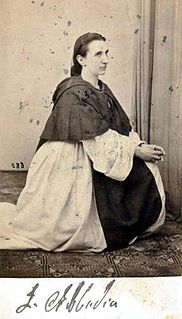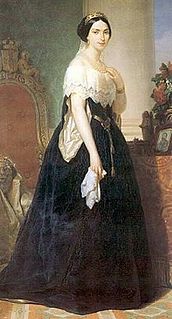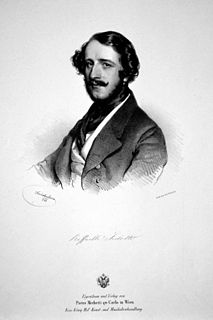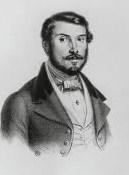Related Research Articles

Maria Anna MarziaAlboni was a renowned Italian contralto opera singer. She is considered "one of the greatest contraltos in operatic history".

Luigia Abbadia (1821–1896) was an Italian operatic mezzo-soprano known for her fine voice, secure technique, and a strong temperament. Possessing an uncommonly wide range, Abbadia sang several roles traditionally portrayed by sopranos in addition to roles from the mezzo-soprano repertoire.

Clorinda Corradi was an Italian opera singer and one of the most famous contraltos in history.
Domenico Reina was a Swiss bel canto tenor, notable for creating roles in the operas of Vincenzo Bellini, Gaetano Donizetti, Saverio Mercadante, and other Italian composers.

Eugenia Tadolini was an Italian operatic soprano. Admired for the beauty of her voice and stage presence, she was one of Donizetti's favourite singers. During her career she created over 20 leading roles, including the title roles in Donizetti's Linda di Chamounix and Maria di Rohan and Verdi's Alzira. She was born in Forlì and studied music there and in Bologna before making her debut in Florence in 1828. She sang in all of Italy's leading opera houses, as well as in Paris, Vienna, and London before retiring from the stage in 1852. She spent her remaining years first in Naples, where she had been the Teatro San Carlo's reigning prima donna for many years, and then in Paris, where she died of typhoid fever at the age of 63. From 1827 to 1834, she was married to the Italian composer and singing teacher, Giovanni Tadolini.
Raffaele Mirate was a celebrated Italian operatic tenor who had an active career from the 1830s through the 1860s. Known for his intelligent phrasing and bright and powerful vocal timbre, he was regarded as an outstanding interpreter of the tenor roles in the early and middle period operas of Giuseppe Verdi. He notably created the role of the Duke of Mantua in the world premiere of Verdi's Rigoletto in 1851. He was also a highly regarded interpreter of bel canto roles, excelling in the operas of Vincenzo Bellini, Gaetano Donizetti, and Gioachino Rossini.
Giovanni Battista Verger was an Italian operatic tenor and impresario. He particularly excelled in the operas of Gioachino Rossini and Gaetano Donizetti.
Antonietta Marini-Rainieri was an Italian operatic soprano active during the first half of the 19th century. She was married to lauded operatic bass Ignazio Marini and often appeared on stage with him. In 1835 she portrayed Giulietta opposite Amalia Schütz Oldosi as Romeo in the Teatro Regio di Parma's first staging of Vincenzo Bellini's I Capuleti e i Montecchi. At La Scala she portrayed roles in the world premieres of Giuseppe Verdi's first two operas: Leonora in Oberto (1839) and the Marchesa del Poggio in Un giorno di regno (1840). She also appeared at that house as the Princess of Navarra in the premiere of Gaetano Donizetti's Gianni di Parigi (1839). In 1843 she sang the title role in the premiere of Giovanni Pacini's Maria, regina d'Inghilterra at the Teatro Carolino in Palermo. She reprised that role in December 1843 at La Scala and at the Teatro Carlo Felice in February 1844.
Elisa Orlandi (1811–1834) was an Italian opera singer who was active at major opera houses in Italy from 1829 until her sudden death in 1834. Possessing a wide vocal range with a significant amount of coloratura facility, she tackled roles from both the mezzo-soprano and soprano repertoires. She is best remembered today for portraying the role of Giovanna Seymour in the world premiere of Gaetano Donizetti's Anna Bolena in 1830.

Adelaide Tosi was an Italian operatic soprano.

Raffaele Ferlotti was an Italian operatic baritone who had an active international career from the 1830s through the 1860s. He was a regular performer in Italy's leading opera houses, especially La Scala, and created roles in several world premieres. On the international stage he performed in operas in Austria, England, France, and Spain.
Raffaele Scalese (1800–1884) was an Italian operatic bass who specialized in the opera buffa repertoire. He was active in Italy's major opera houses from the mid-1820s up into the 1860s. He also appeared internationally in opera houses in Austria, Portugal, and France. The last years of his career were spent performing in Paris in the late 1860s where he remained after his retirement from the stage.
Teresa Ruggeri was an Italian operatic soprano who had an active career from the 1820s through the 1840s. In 1827 she portrayed the role of Zarele in the world premiere of Giovanni Pacini's Gli arabi nelle Gallie at La Scala in Milan. She performed in several more world premieres at that house, including Francisca in Gaetano Donizetti's Maria Padilla (1841), Anna in Giuseppe Verdi's Nabucco (1842), and Viclinda in Verdi's I Lombardi alla prima crociata (1843). Other roles she performed at La Scala included Baroness Aspasia in Gioachino Rossini's La pietra del paragone (1829), Giannetta in Donizetti's L'elisir d'amore (1835), Alisa in Donizetti's Lucia di Lammermoor (1839), The Marquise of Birkenfeld in La fille du régiment (1840), and Giovanna in Verdi's Ernani (1844) among others.

Giacomo Roppa was an Italian operatic tenor who was active career in Italy's most important opera houses from the 1830s through the 1850s. He also made appearances at the Liceu in Spain. He is best remembered for creating the role of Jacopo Foscari in the world premiere of Giuseppe Verdi's I due Foscari in 1844.

Antonio Poggi was an Italian operatic tenor who had an active international career from 1827–1848. He is best remembered for creating roles in the world premieres of operas by Gaetano Donizetti and Giuseppe Verdi. He was married to soprano Erminia Frezzolini from 1841–1846.

Vincenzo Negrini was an Italian bass-baritone opera singer. Born in Cesena, he sang leading bass and baritone roles in Italy's major opera houses and created several roles in early 19th-century operas, most notably Oroveso in Bellini's Norma and Folco in Donizetti's Ugo, conte di Parigi. Severe heart disease caused him to retire from the stage in June 1840. He died in Milan two months later at the age of 35.
Ayres Borghi-Zerni was an Italian operatic soprano who had a distinguished international career from 1914 till 1928.
Jolanta Omilian, real name: Jolanta Omiljanowicz-Quattrini, is a Polish opera singer, singing mainly belcanto and dramatic soprano parts.

Carolina Bassi was an Italian contralto who knew Rossini, Meyerbeer, Donizetti and Bellini.
Savino Monelli was an Italian tenor prominent in the opera houses of Italy from 1806 until 1830. Amongst the numerous roles he created in world premieres were Giannetto in Rossini's La gazza ladra, Enrico in Donizetti's L'ajo nell'imbarazzo and Nadir in Pacini's La schiava in Bagdad. He was born in Fermo where he initially studied music. After leaving the stage, he retired to Fermo and died there five years later at the age of 52.
References
- 1 2 3 4 Casaglia, Gherardo (2005). "Marietta Sacchi" . L'Almanacco di Gherardo Casaglia (in Italian).